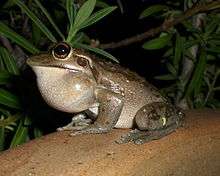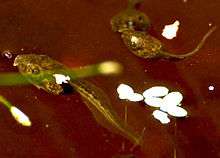Motorbike frog
| Motorbike frog | |
|---|---|
| | |
| Scientific classification | |
| Kingdom: | Animalia |
| Phylum: | Chordata |
| Class: | Amphibia |
| Order: | Anura |
| Family: | Hylidae |
| Genus: | Litoria |
| Species: | L. moorei |
| Binomial name | |
| Litoria moorei Copland, 1957 | |
| | |
| Distribution of Litoria moorei[2] | |
The motorbike frog (Litoria moorei) [3] is a frog well known in Southwest Australia. It is a ground-dwelling tree frog of the Hylidae family, one of only three species of hylids occurring in that region. Its common name comes from the male frog's mating call, which sounds similar to a motorbike changing up through gears; it is also known as Moore's frog,[1][3] the Western bell frog, the Western green and golden bell frog,[4] and the Western green tree frog.
Description
L. moorei is able to camouflage itself well, and ranges in colour from dark brown, through green, to gold. The underside is noticeably lighter, and usually ranges from very pale green to light brown. The light green of the groin and thigh distinguishes this species from its cogenor, Litoria cyclorhyncha, which is darker and spotted with yellow there.
Typical of tree frogs, its toe pads enable it to climb smooth vertical surfaces. Its hind legs are powerful, and the toes are webbed. In mating season, the males develop black nuptial pads that enable them to cling to the females' backs during amplexus. These pads can be up to 7 cm in length.[3]
The tadpole's body is a uniform dark brown above with a silvery sheen below; initially minute in size, they grow to a very large 80 mm in length.[3] The tadpoles usually hide amongst vegetation, but are easily encouraged out of hiding when food is presented. For most of their time as tadpoles, they crowd together in schools.
Ecology and behaviour

Breeding season is from early spring through to late summer. The male's mating call sounds like a motorbike changing gears. The males usually find a suitable clump of reeds or other water plants from which to call. When a female joins the male in the water, the male grips onto the female’s back, using his nuptial pads, that appear during breeding season. Large clumps of eggs, encased in a transparent jelly, are attached to floating vegetation and debris.
Despite being a tree frog, L. moorei seldom climbs higher than 1–2 m, on plants, shrubs, brick walls, or windows.
Their diets consist mainly of arthropods, but also include smaller frogs, including juveniles of the same species. The tadpole's main diet is algae, but they will also eat animal matter when available. Tadpoles, like adult frogs, sunbathe for one or two hours each day for healthy growth.
A wide and populous distribution through lakes and swamps has readily incorporated garden ponds and farm dams, where they are often found sunbathing on the upper leaves of plants. They can live without water for extended periods of time.
L. moorei is a member of the Litoria aurea complex. Unlike the eastern members of the complex (Litoria aurea, L. raniformis and L. castanea), the motorbike frog has not suffered from dramatic declines, despite chytrid fungus being present in areas which they inhabit.
Distribution

South-west corner of Western Australia,[2][5] from as far north as the Geraldton Sandplains,[6] to the Esperance Plains on the south coast of WA.[7]
There is a population on Rottnest Island.[4]
The species is one of the most well known frogs found in urban Perth areas.[8]
The estimated altitudinal range of the species is from 0-600m asl.[1]
See also
Green and golden bell frog - closely related.[9]
Notes
- 1 2 3 International Union for Conservation of Nature and Natural Resources. "Litoria moorei". http://www.iucnredlist.org. Retrieved 27 September 2014. External link in
|website=(help) - 1 2 Black, Dave. "Frogs of Australia > Litoria moorei / Motorbike Frog". http://frogs.org.au. Retrieved 27 September 2014. External link in
|website=(help) - 1 2 3 4 "Motorbike Frog". http://museum.wa.gov.au. Western Australian Museum. Retrieved 27 September 2014. External link in
|website=(help) - 1 2 "Backyard Buddies: Motorbike Frogs". http://fnpw.org.au. Retrieved 27 September 2014. External link in
|website=(help) - ↑ Atlas of Living Australia. "Search: Species: Litoria moorei : Motorbike Frog Occurrence records". http://biocache.ala.org.au. Retrieved 27 September 2014. External link in
|website=(help) - ↑ "Occurrence record: REPT:R96682". Atlas of Living Australia (http://biocache.ala.org.au). Retrieved 27 September 2014.
- ↑ "Occurrence record: REPT:R64692". Atlas of Living Australia (http://biocache.ala.org.au). Retrieved 27 September 2014.
- ↑ Michael J. Bamford; Natalia Huang (2009). "The Occurrence and Status of Frogs in the Gnangara Sustainability Strategy Study Area" (PDF). http://www.water.wa.gov.au. Retrieved 27 September 2014. External link in
|website=(help) - ↑ "The Green and Golden Bell Frog Key Population at Kurnell" (PDF). http://www.environment.nsw.gov.au. Retrieved 27 September 2014. External link in
|website=(help)
References
- Barker, J.; Grigg, G.C.; Tyler, M.J. (1995). A Field Guide to Australian Frogs. Surrey Beatty & Sons. ISBN 0-949324-61-2.
- "Amphibian Species of the World - Litoria moorei (Copland, 1957)". Retrieved 28 August 2006.
- "Frogs of Australia > Litoria moorei / Motorbike Frog". Retrieved 28 August 2006.
External links
-
 Media related to Motorbike frog at Wikimedia Commons
Media related to Motorbike frog at Wikimedia Commons -
 Data related to Motorbike frog at Wikispecies
Data related to Motorbike frog at Wikispecies
